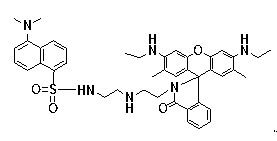Acid-sensitive double light emission probe, preparation method and uses thereof
An emission probe, acid-sensitive technology, applied in the field of probes, to achieve the effects of sensitive method, sensitive pH ratio determination, and simple synthesis
- Summary
- Abstract
- Description
- Claims
- Application Information
AI Technical Summary
Problems solved by technology
Method used
Image
Examples
Embodiment 1
[0029] Embodiment 1: the synthesis of Danyl-R6G
[0030] Add Rhodamine 6G (10 g) to 100 ml diethylenetriamine in a tube or bottle with a cap, and stir the reaction at 60°C until the color of Rhodamine 6G disappears. 500 ml of water was added to the reaction solution, and the mixture was extracted with dichloromethane. The organic phase was heated to remove the solvent, and the obtained solid was separated and purified by silica gel column to obtain a colorless solid (9 g). The solid was added to 100 ml of dichloromethane, followed by 3 g of dansyl chloride and 10 ml of triethylamine. The reaction was stirred at room temperature for 2 hours. The organic phase was heated to remove the solvent, and the obtained solid was separated and purified by silica gel column to obtain Danyl-R6G (5 g). Synthetic route see figure 1 .
Embodiment 2
[0031] Example 2: The ratiometric pH titration of Danyl-R6G under dual-wavelength light excitation
[0032] Danyl-R6G was prepared into a solution with a final concentration of 1 μg / ml in sodium phosphate buffer with different pH gradients, and the fluorescein excitation spectrum excited at 300 nm and the rhodamine 6G lactam excited at 532 nm corresponding to different pH were measured spectrum. see results image 3 and Figure 4 ;
[0033] image 3is the fluorescence emission spectrum of Dansyl-R6G in pH 8.0, 7.5, 7.0, 6.5, 6.0, 5.5, 5.0, 4.5, 4.0, and 3.5 buffer solution (the excitation wavelength of Dansyl-group is 300 nm, R6G-lactam group The excitation wavelength of the group is 532 nm). The abscissa is the fluorescence emission wavelength, and the ordinate is the fluorescence emission intensity; it can be seen from the figure that when the pH of the buffer varies from 5.5 to 3.5, the Danyl group emits the optimal fluorescence intensity at 485 nm, while R6G emits th...
Embodiment 3
[0035] Example 3: Localization of Danyl-R6G in L929 cells
[0036] L929 cells (from American Type Culture Collection) were cultured in a medium containing 0.1 mg / ml Danyl-R6G and Lyso Tracker green DND 26 for 2 hours, removed the culture medium and washed twice, replaced with new medium and continued to culture for half an hour . Followed by fluorescence confocal instrument (Zeisis 780) analysis, the results are shown in Figure 5A , 5B , 5C, 5D, where Figure 5A Fluorescence for LysoTracker Blue DND 26, Figure 5C is the fluorescence of the R6G-lactam group, Figure 5B is the fluorescence of the Dansyl group. Figure 5D The superimposed picture of the three shows that the distribution position of the three in the cell is the same. The scale length is 10 μm. It can be seen that the R6G signal ( Figure 5C ) can be clearly detected with Danyl-stained fractions ( Figure 5B ) similarly, suggesting that lysosomal pH regulates the ring opening of the R6G group of the pr...
PUM
 Login to View More
Login to View More Abstract
Description
Claims
Application Information
 Login to View More
Login to View More - R&D
- Intellectual Property
- Life Sciences
- Materials
- Tech Scout
- Unparalleled Data Quality
- Higher Quality Content
- 60% Fewer Hallucinations
Browse by: Latest US Patents, China's latest patents, Technical Efficacy Thesaurus, Application Domain, Technology Topic, Popular Technical Reports.
© 2025 PatSnap. All rights reserved.Legal|Privacy policy|Modern Slavery Act Transparency Statement|Sitemap|About US| Contact US: help@patsnap.com



